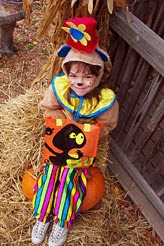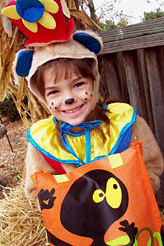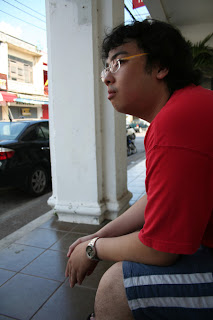A camera is your media, so the better you understand the media, the better your pictures are likely to be. The two most useful controls are:
1. Focal Length (the zoom of your lens), which affects how much of the view is included in the shot, and;
2. Depth-Of-Field (the f-stop of your lens), which affects how much of the foreground and background is in focus.
To use these techniques effectively, you need to understand lenses and exposure.
Lenses
The first thing to play with on most cameras is the lens. A long lens (say 210mm), allows you to zoom-in to your subject, to get close to it. A short lens (say 35mm), is often called a wide-angle lens because it allows you to zoom-out and get a wider view.
The numbers (e.g. 210mm) represent the focal length of the lens. This is the distance between the focal plane (film) and where the light rays appear to originate (when focused on infinity).
You can select the focal length based on what you want included in the shot, and how you want to portray depth. A short lens exaggerates depth, combining a close foreground with a deep background. This is a popular pro technique where a close foreground (flowers or roadway) sweeps back into the far horizon. To do this (called hyperfocal) you need a wide lens (say 20mm to 28mm) and a wide depth-of-field (small aperture such as f22 - see later).
A long lens on the other hand contracts the image, giving it narrow depth. Distant elements are put on the same focal plane, making them look closer together than they really are. This is useful to create a flat image, or to emphasize the scale of your background relative to your foreground.
Exposure - Four FactorsA camera is just a box with a hole in it. The correct exposure is determined by four factors:
1. How large this hole is (the aperture);
2. How long it stays open for (the shutter speed);
3. How quickly the camera reacts (the ISO), and:
4. How much light is reflected off the subject (the light level).
Fortunately, most cameras are automatic and will make all these decisions for you. However, higher-end cameras allow you to intervene to create particular effects. Its useful to understand how these four factors interact so that you can use them to your creative advantage.
Let's review each factor in turn (in order of usefulness) and see how it can improve your photography.
1. ApertureInside the lens is an adjustable device, the diaphragm, which alters the size of the opening - the aperture. Changing the aperture is useful as it has a handy side-effect. A very small aperture makes everything (background and foreground) in focus. A large aperture makes only the subject you're focused on in focus. Try squinting your eyes (everything is in focus) and then opening them wide (some things are blurry).
This zone of acceptably sharp focus extends both in front of and behind of the point of focus. It's called the depth-of-field. With landscapes, we usually want a wide depth-of-field to get both the background (hills or mountains) and the foreground (a flower or your travelling companions) in focus. With portraits, we want to emphasize the foreground (a person's face) so we make the background blurry by using a narrow depth-of-field.
How can you tell how much of the image is going to be in focus? The depth-of-field is affected by three things: the size of the aperture; the focal length of the lens; and the distance to the subject you're focused on (the focal distance). To make things easier, the first two items are combined to give us a field number, or f-number. The bigger the f-number (say f11 or f22), the bigger the depth-of-field (the wider the zone of focus).
2. Shutter SpeedInside the camera is a mechanism (a shutter) which controls how long light is allowed to act on the film. When you take a photograph (by pressing the shutter-release), the shutter opens and then closes a fraction of a second later. How quickly this is done is called the shutter speed and is measured in seconds (shortened to s). A fast shutter speed (say 1/500th of a second) is good for action shots as it freezes movement. A slow shutter speed (say 1/60s) blurs moving objects, which is useful when you want to emphasize movement and speed.
Most of the time you will select a shutter speed based on the size of your lens. This is because when you hold a camera, you introduce unwanted movement, called camera shake, and how much of this shake is noticed on the photograph depends upon how much you are zoomed in.
A good rule of thumb says that you're safe with a shutter speed equal to, or faster than, the length of your lens. For example, with a wide lens of 35mm, you're fine with a shutter speed of 1/60s. But when zoomed in to 210mm, you need a faster shutter speed of 1/250s.
3. Light LevelThe amount of light is usually set by mother nature. Generally, the brighter a view is, the better the photograph.
If someone is in the shade, you can add light to their face by using a flash unit. This is called fill-flash because it fills in some light. You can do the same thing with a reflective surface, such as white card or a purpose-made reflector.
If a sky is too bright, you can reduce the amount of light with a filter (such as a gradiented neutral-density filter).
4. Camera SpeedHow quickly the camera reacts to light is known as the speed. Digital cameras often have several speeds available, known as "ISO" settings, which can be chosen manually or automatically. ISO stands for the International Standards Organization which developed a system for film where a 200 ISO is twice as fast (i.e. it reacts twice as quickly) a 100 ISO. (You may have also heard of ASA or DIN - these were two other standards which were replaced by the ISO.)
Why not just have a fast ISO? There is a trade-off between speed and quality. Generally it is preferable to use a slower speed (say 100 ISO) as it gives a sharper image (a finer grain). But when there isn't enough light (indoors or at night), you'll need a faster speed (say 400 or 1600 ISO) and will have to suffer it's less-distinct image (coarser grain).
Combining the Four FactorsTo get the optimum exposure, you must consider all four factors - aperture, shutter speed, light level, and camera speed. Always remember that these four factors are all interrellated. When you set one, you must juggle the others to get the right exposure. Usually you'll be balancing your preferred aperture with a suitable shutter speed.
For example, say you're shooting a landscape with a 100mm lens set to f5.6. When you activate the light meter in your camera, based on the light level and the film speed, it recommends a shutter speed of 1/125s. So your factors are: f5.6, 1/125s, a fixed light level, and your film speed. The f5.6 aperture is giving you a medium depth-of-field - a blurry foreground to a sharp background.
Now lets say that you want both the background and the foreground elements to be in focus. You therefore select a larger f-number, going up a stop from f5.6 to f8. This halves the aperture, so, to compensate, you need to double the shutter-speed from 1/125s to 1/60s. You have successfully juggled your factors.
Unfortunately, this has now taken you past the slowest speed for your lens when hand-held (100mm => 1/100s) and will make a blurry image due to camera shake. So you either need to change to a wider-angle lens (say 50mm), change to a faster film, or find some support for your camera such as a wall or tripod.
SummaryEnhance the creativity of your photographs by intelligently choosing the length of your lens and its aperture.

 A plain background shows off the subject you are photographing. When you look through the camera viewfinder, force yourself to study the area surrounding your subject. Make sure no poles grow from the head of your favorite niece and that no cars seem to dangle from her ears.
A plain background shows off the subject you are photographing. When you look through the camera viewfinder, force yourself to study the area surrounding your subject. Make sure no poles grow from the head of your favorite niece and that no cars seem to dangle from her ears.
 Direct eye contact can be as engaging in a picture as it is in real life. When taking a picture of someone, hold the camera at the person's eye level to unleash the power of those magnetic gazes and mesmerizing smiles. For children, that means stooping to their level. And your subject need not always stare at the camera.
Direct eye contact can be as engaging in a picture as it is in real life. When taking a picture of someone, hold the camera at the person's eye level to unleash the power of those magnetic gazes and mesmerizing smiles. For children, that means stooping to their level. And your subject need not always stare at the camera.
